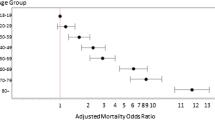Abstract
Motor vehicle crashes are the leading cause of death for adolescents. Previous studies with adults found an association between weight status and decreased use of seat belts. Research has also found significantly higher morbidity and mortality rates in obese individuals who are involved in motor vehicle crashes. If these relationships hold true in obese adolescents they represent additional risk factors for complications from motor vehicle trauma. Given the prevalence of obesity in adolescents (17.4%) and the increased risk of harm associated with obese individuals involved in motor vehicle crashes, this study explored whether there was an association between obesity in adolescents and their use of seat belts. Initial investigation found that rarely/never wearing seat belts was significantly greater for African Americans (22.6%), 18 years of age or older (19.4%), lived with adults other than both parents (15.7%), and males (15.4%). Bivariate logistic regression analysis controlling for demographic variables found that there was no statistically significant difference between overweight and normal weight adolescents. However, obese students were 1.72 times as likely as normal weight students to never or rarely wear their seat belts when riding in a car as a passenger. In particular, obese females and obese students in the middle school age ranges were statistically significantly more likely than normal weight students to never or rarely wear their seat belts.
Similar content being viewed by others
References
Dellinger, H. M., Sleet, D. A., Shults, R. A., Rinehart, C. F. (2007). Interventions to prevent motor vehicle injuries. In L. S. Doll, S. E. Bonzo, J. A. Mercy, & D. A. Sleet (Eds.), Handbook of injury and violence prevention (pp. 55–79). New York, NY: Springer.
Gardner, R., Smith, G. A., Chaney, A. M. L., Fernandez, S. A., & McKenzie, L. B. (2007). Factors associated with hospital length of stay and hospital charges of motor vehicle crash-related hospitalizations among children in the United States. Archives of Pediatrics and Adolescent Medicine, 161, 889–895.
Centers for Disease Control and Prevention. (2006). Youth risk behavior surveillance—United States, 2005. MMWR Morbidity Mortality Weekly Report, 55(SS-5):1–108.
Everett, S. A., Shults, R. A., Barios, L. C., Sacks, J. J., Lowry, R., & Oeltmann, J. (2001). Trends and subgroup differences in transportation-related injury risk and safety behaviors among high school students. Journal of Adolescent Health, 28, 228–234.
Kim, S., Depue, L., Spence, L., & Reine, J. (2009). Analysis of teenage seatbelt use: From the 2007 Missouri high school seat belt survey. Journal of Safety Research, 40, 311–316.
Goldbaum, G. M., Remington, P. L., Powell, K. E., Hogelin, G. C., & Gentry, E. M. (1986). Failure to use seat belts in the United States: The 1981–1983 behavior risk factor surveys. Journal of the American Medical Association, 255, 2459–2462.
Lichtenstein, M. J., Botton, A., & Wade, G. (1989). Body mass as a determinant of seat belt use. American Journal of the Medical Sciences, 297, 233–237.
Hunt, D. K., Lowenstein, S. R., Badgett, R. G., & Steiner, J. F. (1995). Seat belt nonuse by internal medicine patients: A missed opportunity in clinical preventive medicine. American Journal of Medicine, 98, 343–348.
Schlundt, D. G., Briggs, N. C., Miller, S. T., Arthur, C. M., & Goldzweig, I. A. (2007). BMI and seatbelt use. Obesity, 15, 2541–2545.
Strine, T. W., Beck, L. F., Bolen, J., Okoro, C., Dhingra, S., & Balluz, L. (2010). Geographic and sociodemographic variation in self-reported seat belt use in the United States. Accident Analysis and Prevention, 42, 1066–1071.
Ogden, C. L., Carroll, M. D., Curtin, L. R., McDowell, M. A., Tabak, C. H., & Flagal, K. M. (2006). Prevalence of overweight and obesity in the United States, 1999–2004. Journal of the American Medical Association, 295, 1549–1555.
Neville, A. L., Brown, C. V. R., Weng, J., Demetriades, D., & Velmahos, G. C. (2004). Obesity is an independent risk factor of mortality in severely injured blunt trauma patients. Archives of Surgery, 139, 983–987.
Zhu, S., Layde, P. M., Guse, C. E., Laud, P. W., Pintar, F., Nirula, R., et al. (2006). Obesity and risk for death due to motor vehicle crashes. American Journal of Public Health, 96, 734–739.
Centers for Disease Control and Prevention. (2010). 2007 youth risk behavior survey. Available at: http://www.cdc.gov/HealthyYouth/yrbs/brief.htm. Accessed 18 March 2010.
Statistical Package for the Social Sciences (SPSS). (2005). Version 14. Chicago: SPSS, Inc.
Author information
Authors and Affiliations
Corresponding author
Rights and permissions
About this article
Cite this article
Price, J.H., Dake, J.A., Balls-Berry, J.E. et al. Seat Belt Use Among Overweight and Obese Adolescents. J Community Health 36, 612–615 (2011). https://doi.org/10.1007/s10900-010-9349-z
Published:
Issue Date:
DOI: https://doi.org/10.1007/s10900-010-9349-z




